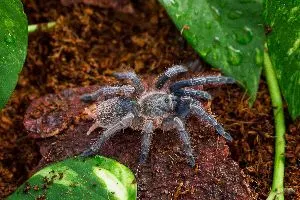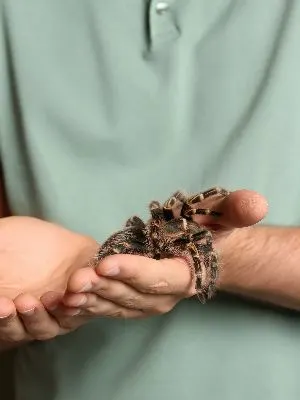Costa Rican Zebra Stripe Knee Tarantula Care
Costa Rican Zebra Stripe Knee Tarantulas are beautiful, but are not a beginner level tarantula. These spiders require an intermediate level of care and are more for experienced keepers.
Beginner tarantula keepers might want to search for a more beginner-friendly pet spider, as this one will definitely be a lot harder to deal with if you lack experience.
This beautiful species has a unique look to them, which is why they are only becoming more and more popular amongst tarantula enthusiasts.
If you are an avid tarantula keeper, this might be a good pet for you so stick around to find out more about how you can properly care for the Stripe Knee Tarantula.
Quick reference section
- Experience Level: Intermediate
- Family: Theraphosidae
- Scientific Name: Aphonopelma seemanni
- Other Names: Striped-knee tarantula, Zebra Tarantulas, Costa Rican zebra tarantula
- Adult Size: 5 to 6 inches
- Lifespan: Males: up to 5 years; Females: Up to 18 years
- Average Price Range: $20 to $100 per spider
- Where to buy: pinchersandpokies.com, Joshsfrogs.com, microwilderness.com, undergroundreptiles.com
Bioactive Zebra Tarantula Setup Product List
- Enclosure: Exo Terra Glass terrarium kit
- Soil: Zoo Med Reptisoil
- Moss: Zoo Med terrarium moss
- Hide: Zoo Med cork hide
- Leaf Litter: Sungrow leaf litter
- Hygrometer: Zoomed hygrometer
- Cleaners: Springtails & Isopods
- Water Dish: Zoo Med small water dish
Striped-knee tarantula Facts

This species of tarantula is a new world terrestrial tarantula, meaning that they come from the Western Hemisphere and have urticating hairs as a defense mechanism.
In Cambodia, they are a delicacy. They are often eaten dehydrated, oven-dried, and salted.
They are also known as Zebra Tarantulas or Costa Rican Zebra Stripe Knee Tarantulas.
Appearance

They get their name from their unique look with parallel lines going down their legs lengthwise and at their joints across, giving the illusion of long legs. These stripes can be white, cream-colored, or even orange.
They are black or dark brown with auburn-brown hairs all over their hardy bodies. Their unique look is what makes them special and highly desired in the community.
Habitat

These species of tarantula can be found in the hotter drier regions of Costa Rica, as their name suggests. They may also inhabit other parts of Central America such as Nicaragua, Guatemala, and Honduras.
They can inhabit a wide range of climates from the tropics to temperate. The areas listed also have a rainy season starting mid-April or at the beginning of May all the way up until December.
Stripe Knee tarantulas are used to areas that have high heat during the day and chilling cold nights. That is why these spiders are prepared for these conditions.
They will create deep burrows underground which will hold the temperatures they require to survive; below the heat of the daytime and above that of the lowest night temperatures.
At the entrance of their burrow, they will lay a silk lining in order to be alerted whenever it is time for a meal.
Diet
In the wild, these tarantulas will feed on crickets as well as other large insects, and every once in a while, a small vertebrate.
Spiderlings will eat pinhead crickets and other smaller insects.
In their deep burrows, they wait for their prey to get caught in their silk screen at the entrance, where they will be caught and ready for the tarantulas to feed.
Lifespan
Just like most tarantulas, females live a lot longer than their male counterparts. Males will die soon after they become sexually mature.
On average, a female Stripe Knee Tarantula will live anywhere up to 18 years of age, whereas males will only live up to around 2 to 3 years. Some males may also live up to 5 years, but it really depends on the spider.
Breeding
Stripe Knee Tarantulas will lay anywhere from 50 to 2000 eggs in one little web ball. These babies will hatch within the span of 6 to 8 weeks.
When tarantulas are ready to breed, the male will deposit his sperm in a small silk sac which he will then store in his pedipalps. Tarantula mating rituals are pretty dangerous and can be life or death for the male.
The male tarantula will first search for a mate and invite her to mate. The male will then attempt to deposit his sperm sac into the female’s pedipalps by holding back her pincers and legs so she cannot attack him.
If he can successfully deposit the sac, he will then have a few minutes to flee after copulation since the female will be entranced with chemicals that come with fertilization.
If the male is not careful or the female thinks he is not a suitable mate, he will become her dinner. If copulation is successful and the female is fertilized, she will then protect the clutch of eggs for about 6 to 8 months, which is the average incubation period until they hatch.
Watch this fascinating mating ritual happen here:
If you are going to attempt to breed your spiders, you need to be fast and ready to remove the male after he fertilizes her.
Legality
In general, tarantulas are legal to keep in most states, although there may be local laws that restrict captivity, breeding, and such. Check out your local laws to find out what is and is not allowed in your state or city.
You can find them at pet stores easily, but we recommend you also try to look for a rescue group or at least make sure you buy from a licensed, reputable breeder.
Striped-knee tarantula care sheet
Enclosure
Stripe Knee Tarantulas require, at the very least, a 5 to 10-gallon enclosure for them to have the space they need to be comfortable.
A good rule of thumb to follow for any tarantula enclosure is making sure that the width of their enclosure is at least three times your spider’s leg span.
You might also want to get something that has an escape-proof lid since tarantulas are quite the escape artists.
Keepers should also be sure to get a well-ventilated enclosure.
These guys are deep burrowers so make sure that it is also tall enough so that you are able to put in a thick layer of substrate to accommodate their natural burrowing needs.
You should clean out their enclosure once every week to ensure a safe and illness-free home for your pet spider.
Watch this how-to on cleaning your tarantula’s tank efficiently:
Substrate
This species of tarantula burrow very deeply, meaning they will need a lot of substrate to accommodate that need. You must pack their substrate down, leaving it at least four inches thick.
We recommend keepers use a good mix of peat moss, soil, or vermiculite for their pet Stripe Knee.
Accessories
In terms of accessories, you might want to add a hide, which you can buy from your local pet store. You can also just lay some cork bark, a small clay flowerpot, or a spider home from the pet shop.
Fake vines and plants are also options to support small climbs, just make sure that they are not too tall since even a fall of a few inches can injure or kill your pet spider.
Temperature
You want to keep the environment in their enclosure at conditions similar to their natural habitat.
Since they are from hot, dry regions of Costa Rica, they require temperatures around 70 to 85 degrees Fahrenheit.
If your house stays cooler than these temperatures, you might want to purchase a tank heating pad to keep your pet comfortable in their enclosure.
Humidity
These tarantulas are able to adapt to a variety of climates including tropical and temperate regions. They will thrive in an environment that has humidity levels of around 65 to 80 percent.
To keep these levels optimal, you should always provide your spider with a small fresh water bowl, which also diminishes the need to mist.
Lighting
Don’t worry about lighting but do keep track and monitor their tank temperatures since it is more essential to their well-being.
You may also want to get a heating pad to keep temperatures in the enclosure stable.
Feeding
As tarantulas molt and grow, their prey should also get larger.
Slings should be fed every 4 to 7 days and their food should not be any larger than their carapace. This includes bugs like pinhead crickets or other smaller insects.
Adults can eat once every week or every 10 days. They will mainly eat crickets but can also enjoy locusts, superworms, and roaches that are a suitable size.
Adults can also enjoy the very occasional pinkie mouse and earthworm, but be careful not to allow them to indulge more than once a month.
Temperament

When it comes to Stripe Knee tarantulas as pets, they are not the most handleable spiders. These guys are for the intermediate keeper for a reason!
While they are relatively easy to care for due to their ability to adapt to most living conditions, they are very skittish creatures. Due to their nature, they will require an intermediate keeper who knows how to handle skittish spiders.
While they will react with their defense mechanisms of fleeing or throwing hairs, they rarely bite. Although, they are easily provoked, which is when they would react defensively.
Handling

Because their skittish behavior causes them to act in sudden bursts of speed, handling them is highly discouraged.
While they are mostly docile, they are highly defensive by nature so trying to pick them up can cause them to act out. They are easily startled, which may cause them to dart quickly, which may cause injury or even death to your spider.
They are known to bite as a last result and will most likely flee or hurt themselves before it tries to hurt you. Trying to handle this species may not be worth the trouble, as it can cause danger to them.
However, some spiders can be mildly tamed with some socializing, gentle handling practice, and patience.
If you are trying to handle or tame your Stripe Knee, please do be gentle with them and go extremely slowly.
Make sure you do so at a close distance to the floor of at least two feet in case they do flee and jump off your hand. If possible, try to do it on a carpet or soft floor to lessen the possibility of injury.
Conclusion
If you are a hobbyist, collector, or tarantula enthusiast alike, the magnificent Costa Rican Zebra Stripe Knee Tarantula is a beautiful spider to add to any collection.
We hope that this article has given you more insight on how to raise a happy, healthy Stripe Knee Tarantula.
Check out this video on the overall care and a lot more information you might want to know about how to care for this species of tarantula:
We think this tarantula is very cool and unique.
More tarantulas stuff
Table of Contents
